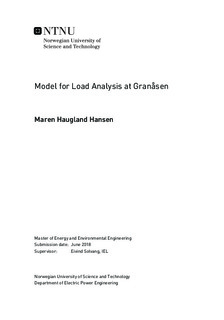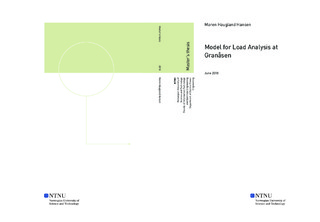| dc.description.abstract | Granåsen ski arena had in 2017 a total energy consumption of 1036.4 MWh, and a maximum power peak of 986 kW. During the next years, Granåsen is facing a comprehensive expansion, which will lead to increased energy and power demand. The purpose of this thesis is to ensure Granåsen to be a sustainable facility, with respect to eventual energy self sufficiency. This work includes analyzis of current load profiles, load modelling and assessment of solar cells.
A bottom up approach to load modelling is used in order to construct load prognoses, involving both engineering and statistical methods. Retrieval of data is therefore emphasized. The system boundaries have been chosen to encompass four central loads of a Granåsen: Lights, snow production, elevator and buildings.
The energy consumption prognoses for the buildings are based on reference data from buildings in Norway with similar functions. A constructed scenario where events, weather, and temperatures are the determining variables, provides an annual energy consumption which corresponds to approximately the double of the current consumption. It is, however difficult to compare the results due to different system boundaries and great uncertainties. It has therefore become evident that the approach performed in this work is more relevant than the numerical results.
PV production potential is found to be 652790 kWh/year when all future available roof is utilized for PV modules. That furthermore corresponds to a 750. 8kW$_p$ plant. A 30 \degree tilt provides the highest annual output, while a 90\degree tilt leads to a higher yield during the winter. PV can, with respect to a 30\degree tilt, contribute to decrease the forecasted load profiles by 35\%. With no energy storage, however, 69,442 kWh excess energy would go to waste during the summer months. PV can also, with no energy storage implemented, to a small extent remove power peaks.
Energy storage together with PV can be very relevant to implement in a sports facility as Granåsen, especially to function as a peak shaving unit. A battery with capacity 720 kWh suggested for this purpose can work as a peak shaving unit for 250 kW during two hours. However, just below 100 batteries are required in order to store all the excess energy for the installed PV and given load scenario. Mobile Energy storage, which works as peak shaving units other places on a daily basis, but collected at Granåsen for special events could be a relevant execution model to get a smoother load profile during the year. | |

